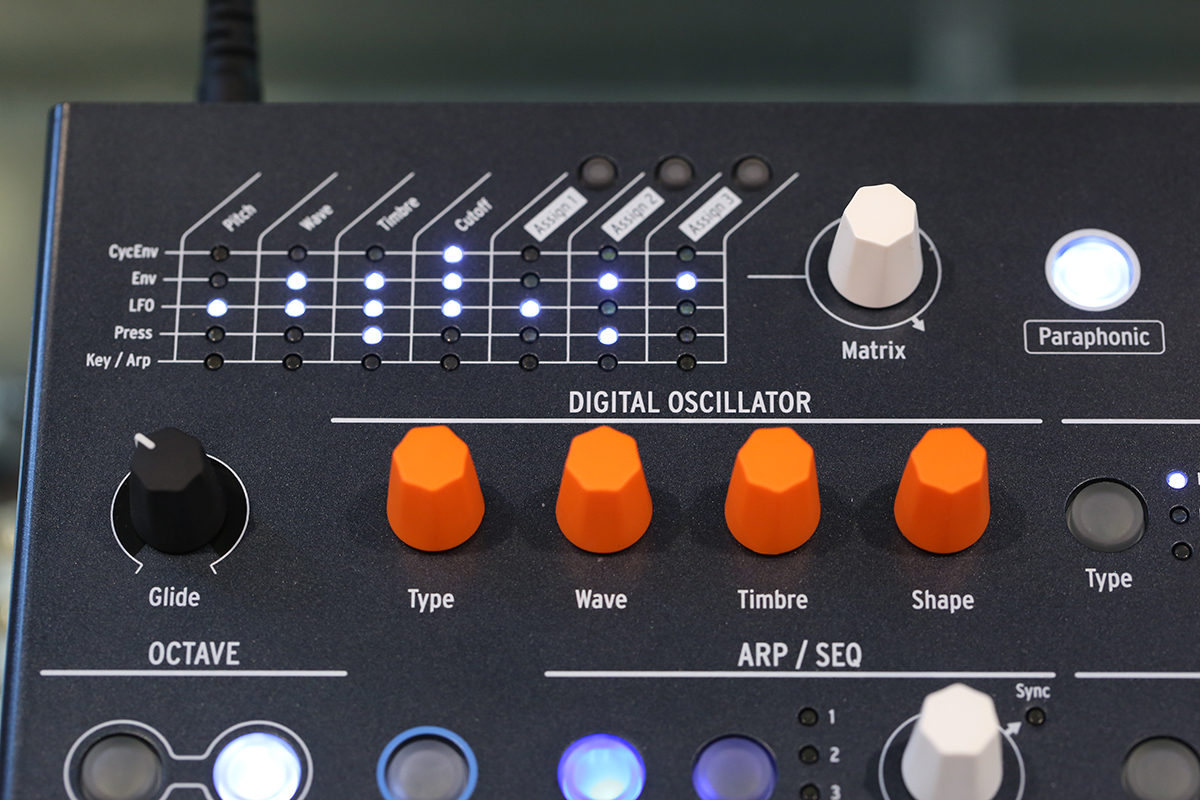Lately, a trend for developing synthesizers that are both portable and robust became widely prominent—and Arturia’s Microfreak belongs exactly to this category of machines. The company’s representative Ian Martinez recently stopped by our shop to demonstrate the full potential of the synth.
Microfreak is a hybrid digital + analog 4-voice paraphonic synthesizer that takes advantage of the best of both worlds. The sound of the synthesizer is largely defined by the complex sound generator section, borrowed in part from the excellent Mutable Instruments Plaits macro-oscillator, and an all-analog 12dB/octave SEM-inspired state variable filter. Microfreak features an LFO with multiple selectable waveshapes, and two envelope generators, one of which is capable of self-cycling. There is a built-in sequencer, arpeggiator, and a capacitive 25-key keyboard equipped with pressure sensors and a pitch-bend slider. Everything is tied down together by the flexible 7x5 modulation routing matrix that provides an easy-to-use framework for designing extremely complex and animated sonic worlds.

The Sound
The oscillator is packed with eleven unique synthesizer models ranging from analog-style traditional waveforms to granular noise to speech synthesis. With such a wide array of oscillator flavors, Microfreak can be easily and quickly adapted to accommodate a plethora of music genres, be it soft ambient textures or heavy bass growls.
Timbres and textures can be further smoothed out or accented by the warm analog filter. Microfreak offers the three most-commonly used filter modes: lowpass, highpass, or bandpass. Note that setting the Resonance parameter to extreme positions forces the filter to self-oscillate, effectively rendering it an additional analog sound source.
Extended Paraphony
Although the overall architecture of the synth is paraphonic, meaning that all the voices share a single filter, Microfreak hosts a hidden set of envelopes and VCAs applied to each voice prior to the master EG and amplifier. This adds an extra layer of dynamics to the synth, making it possible to set individual amplitude levels per voice.

Modulation and Control
The onboard Low Frequency Oscillator offers a selection of six shapes ranging from plain sine wave to stepped and smooth random sources. Additionally, as one of the envelopes can be set to a looping mode, it can double as a second LFO when needed.
The arpeggiator on Microfreak deciphers the chords into individual notes and offers a few different ways to organize them in sequence. When set to Up mode, the notes of the chord are played low-to-high. In Order mode, the notes cycle in the same sequence as they were pressed. When set to Random, the notes of the chords alter arbitrarily. Finally, there is the Pattern mode, which intelligently generates a variation on the pattern each time the key is pressed. The length of the arpeggios in the pattern mode is connected to the length of the sequencer, ranging from a minimum of four steps to a maximum of 64.

As stated before, Microfreak is also endowed with a very capable sequencer applicable to all of the four voices of the synth. The intuitive operation of the sequencer is established by recording the performance data (pitch, duration, and pressure) and then playing it back at user-definable speeds. Two sequencer patterns, A and B, can be recorded and easily alternated between during the performance. The sequencer has four additional modulation tracks which are essential for creating lively and animated patterns. Essentially, modulation sequences are created by recording and storing snapshots of the parameter knobs' positions along with the sequencer steps.
The modulation matrix is the final piece that delineates the rich sonic potential of the Microfreak. Five modulation sources (LFO, two Envelopes, Pressure, and Key/Arp) can be freely routed to any or all of the seven destinations. While the usual suspects for modulation like the oscillator Pitch, Waveform, and Timbre, as well as filter’s Frequency Cutoff, are immediately available, there are three additional slots that are user-assignable. Exploring and utilizing the modulation matrix on Microfreak is key for creating unique, never-before-heard sounds.
Interconnectivity
Making Microfreak play along with other gear in your setup couldn’t be any easier given the number of options for connectivity. On the back panel of the synthesizer, you’ll find 3.5mm MIDI I/O, Clock input and output, as well as CV, Gate, and Pressure outputs derived directly from the touchplate keyboard.
Although there are many more things we couldn’t talk about in the short span of this article, Microfreak carves a special place for itself in the world of synthesizers. It is simple and intuitive enough to be appreciated by beginners, yet it has enough depth to excite even the most experienced synthesist.







